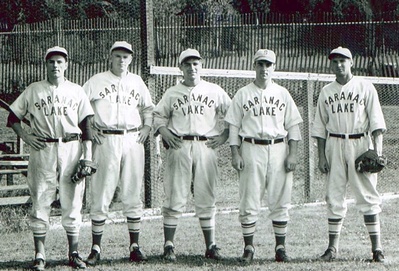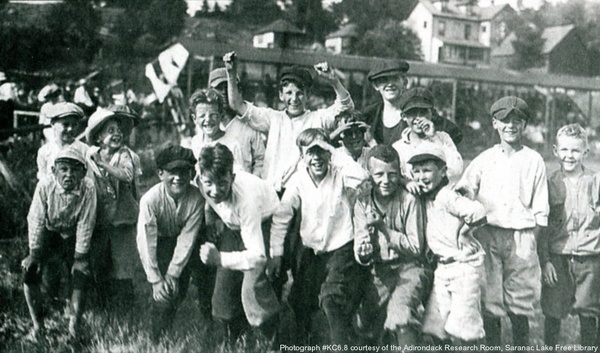 Young fans at a baseball game near the field where Petrova School was later built, 1914.
Young fans at a baseball game near the field where Petrova School was later built, 1914.
Adirondack Daily Enterprise, July 9, 2011 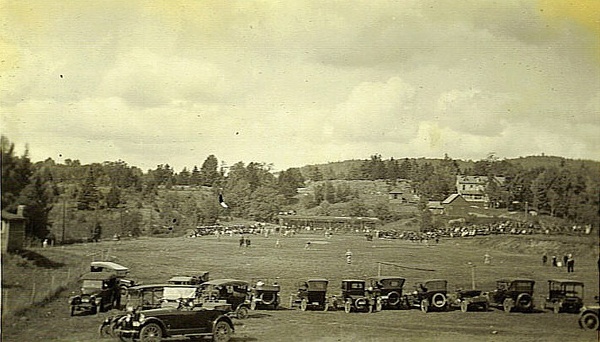 Early Saranac Lake baseball game. William F. Kollecker (Digital image, Historic Saranac Lake collection)
Early Saranac Lake baseball game. William F. Kollecker (Digital image, Historic Saranac Lake collection) 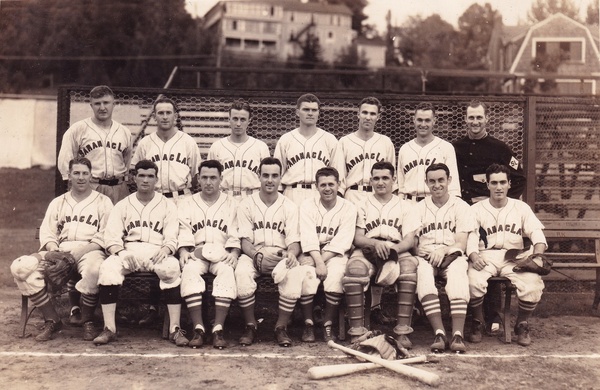 Saranac Lake Red Sox, 1936.
Saranac Lake Red Sox, 1936.
Historic Saranac Lake Collection, 2023.3.57. Saranac Lake and other Adirondack towns invited college baseball teams to play for the amusement of summer guests as early as 1889.
Later, from at least 1948, 1 town teams were common; the Adirondack Enterprise carried stories about local Adirondack League/Northern League (1935-1952) 2 baseball teams through at least 1960.
Earlier teams included the Altamont Dairymen, the Lake Placid Majestics, and the College All-Stars; there was also at least one girls team.3
Elizabethtown Post, June 6, 1889
The Saranac Lake base ball team crossed bats with the boys at Bloomingdale a week ago to-day. The Bloomingdale team won by a score of 80 to 8.
Malone Gazette, August 12, 1892
Ampersand Downs Malone.
We give below the score by innings, with a technical summary, of the Malone and Ampersand game of ball played at Saranac Lake on Wednesday, Aug. 3d, in which the Malones were defeated by a score of 11 to 2. It was the first game of the season for the boys, who were not "up their records" from lack of practice. Several new men were also in the nine from last year and it was not to be expected that a close game could be put up at the first trial. With practice, however, the club will be better than last season.
[…]
Another for Ampersand.
The return game between the Ampersand and Malone ball club was played at the fair grounds in this village last Wednesday The Ampersands came by special train, arriving at Malone at noon and bringing a large delegation from Saranac village, Paul Smith's and other stations with them. Forty tickets were sold at Saranac alone. Both clubs were in fine condition and although a light shower fell at one o'clock it was a good day to play ball.
The game was called promptly at 2:45, the Malones going first to the bat. They succeeded in getting one run, retired their opponents without a score. At the end of the second inning the game stood 1 to 0 in favor of Malone and it looked as if the boys would retrieve their misfortune at Saranac. In the third inning, loose playing gave the Ampersands five runs and from that time until the game was called on account of rain Malone failed to get a run. Ampersand then had a lead of ten scores and appeared to be good for several more. A terrific thunder shower drove the men to cover after the close of the first half of the seventh inning and as the field was flooded with water the balance of game was not played.
Franklin Gazette, August 23, 1895
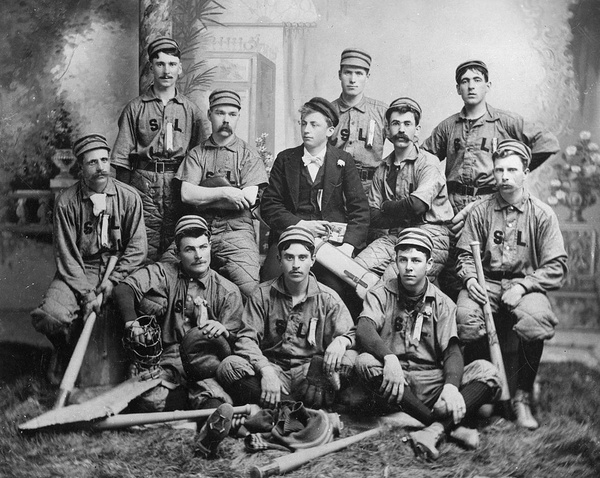 Saranac Lake Baseball Club, 1895
Saranac Lake Baseball Club, 1895
J. Willard Marriot Library, University of UtahDuring a base ball game last Friday at Saranac Lake between the Ampersands and Paul Smith's teams, John E. Smith, a member of the latter club, while at bat was struck by a curved ball pitched by Beman, a Harvard college man, who was playing with the Ampersands. Smith fell to the ground unconscious and when physicians were summoned it was found that his skull had been fractured and that he was dangerously injured. It is reported that he is now somewhat improved and that recovery is probable. The accident proved a sad ending to a day's sport, although no blame can be cast upon tbe pitcher, under the circumstances.
Plattsburgh Daily Press, August 5, 1896
The next baseball game will take place, at Saranac Lake on Saturday, August 8, when the Ampersand and Grand View teams will meet in their second championship game of the season. This will be an exciting game, as both teams are putting forth their best efforts to have strong teams on the diamond. The Ampersand nine expects some new men during the week, aud with their present material, should develop a strong team.
Franklin Gazette, May 28, 1897
The base ball enthusiasts of Saranac Lake have raised $500 for the support of a team during the season and the manager is now looking for players. If the team joins the Northern League the pennant may come to Franklin county again this year after all.
Elizabethtown Post, July 14, 1898
Saranac Lake beat Tupper Lake at baseball July 4th, the score being 17 to 8. Admirers of Robert Kingman's ability as a bail player will be interested in the following facts : That he played centre field on the Saranac Lake nine, that he made 4 scores, more than anyone else on either team, that he stole four bases and that he made no errors.
Plattsburgh Sentinel, July 15, 1898
Annual race meetings of Saranac Lake Driving Association at Saranac Lake next Tuesdays Wednesday and Thursdays, July 12, 13 and 14. Horse races, base ball and a general good time. Purses, $1,250. Special low rates on all railroads.
Elizabethtown Post, May 12, 1904
Saranac Lake High School Wins Two Games.
The Saranac Lake High School base ball nine and the Lake Placid High School team have met on the diamond twice this year, the former winning both times. The first game was 13 to 9. The last game, played Friday, the score was 24 to 23.
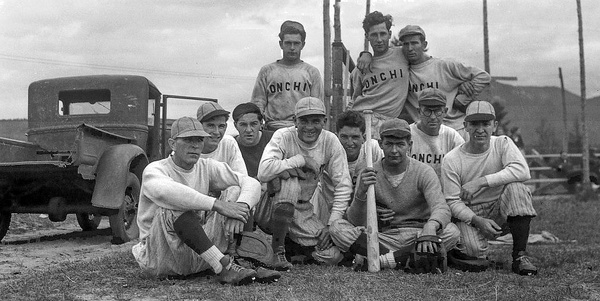 Onchiota Baseball Team, undated.
Onchiota Baseball Team, undated.
Courtesy of Phil FitzgeraldNew York Times, August 16, 1908
ADIRONDACK BASEBALL Whole Region Turns Out To See Paul Smith Team Beaten By Stevens House.
Special to The New York Times, PAUL SMITH'S, N. Y., Aug. 15.-The crowning event of the season at Paul Smith's Hotel on Lower St. Regis Lake was a game of baseball between Paul Smith's and the Stevens House of Lake Placid. The camps along the St. Regis Lakes were practically depopulated for the afternoon. The game resulted 2 to 1, in favor of the Stevens House. The return game was played this afternoon on the Stevens House field.
Paul Smith's "team played the Loon Lake team on the home grounds Wednesday and the Malone team at Malone yesterday…
Lake Placid News, July 6, 1917
ADIRONDACK JOTTINGS
There is a considerable amount of talk about the revival of baseball in Saranac Lake, and persons interested are seeking to “start something'' along this line. With the Pontiac team available the possibility that the old familiar call of “Play Ball!” will be heard in the near future is regarded as particularly bright.
Adirondack Record-Elizabethtown Post, March 31, 1922
SULLIVAN WILL LEAD SARANAC LAKE'S NINE
The baseball fans of Saranac Lake are looking forward to a big season and preparations are being made to finance another team of last year's caliber. Daniel E. Sullivan, coach of Dean Academy, Franklin, Mass., who has piloted the Saranac teams for the past two seasons, will be back on the job again this season and was in Saranac Lake this week for a conference with the committee which has charge of baseball in the village. Saranac Lake, despite the high salaries paid the players and the other heavy expenses with which the team had to contend, finished financially ahead last season.
The board of education has agreed to allow the team the use of the school grounds for a diamond. This will be a big help to the Saranac Lake baseball association and the town is planning for one of the best teams and most successful seasons it has ever had.
Lake Placid News, May 6, 1938
C. of C Recommends Appropriation of $3,500
The Saranac Lake chamber of commerce has recommended an allocation of $3,500 for an all-year sports program. The baseball team will receive $1,500.
The directors of the chamber also recommends [sic] that adequate grandstand facilities be constructed on municipal field. A general development of the field is anticipated with a WPA grant.
The baseball committee of the Saranac Lake Sports association had already signed with Manager Doc Gautreau and with more than half of the team. The members of the committee were getting a little jittery at the thought of the contracts all ready made and no financial assistance from the village. Baseball has never been a paying proposition in that village and the committee had visions of being forced to carry on a campaign among the merchants to raise sufficient funds to see the team thro.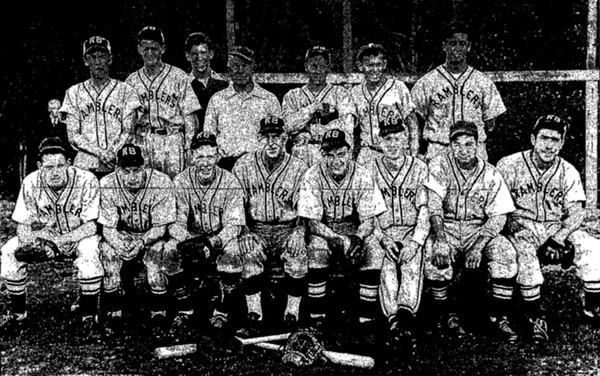 Ray Brook Ramblers, 1948. Front row, left to right: Dud Branch, Ronnie Martelle, Dave Munn, coach I.B. Hunt, Ned Pendergast, Harley Webb, Art Levey and Bob Reyell. Back row- Ken VanOrman, Don Manely, Jack Brockman, coach Harry Sweeney, Nate Pratt, Bob Stringer and Jimmy Duprey.
Ray Brook Ramblers, 1948. Front row, left to right: Dud Branch, Ronnie Martelle, Dave Munn, coach I.B. Hunt, Ned Pendergast, Harley Webb, Art Levey and Bob Reyell. Back row- Ken VanOrman, Don Manely, Jack Brockman, coach Harry Sweeney, Nate Pratt, Bob Stringer and Jimmy Duprey.
Adirondack Daily Enterprise, December 15, 2001
Speed skating will receive $1,500 of the allocation and boat racing $500. The three sports will make up the principal part of the village's program.
The following is based on an article by Bill Johnson, "A bygone era of baseball in the Tri-Lakes", Adirondack Daily Enterprise, October 11, 1997
Town teams date to the mid-1920s. Throughout the US, towns, and villages fielded teams made up of local, college or former professional ballplayers who played games in the afternoon and evenings while holding down day jobs, often as farmhands.
In the 1930s, the Saranac Lake Red Sox was the local team, playing in the old Northern League, which included northern New York and Vermont. Starting in the early 1930s, the Red Sox suffered early growing pains as more established teams such as the Lyon Mountain Miners, Plattsburgh Majors, and Ogdensburg Maples routinely beat them.
Red Sox management decided to improve their odds by bringing in some semi-pro ballplayers. Unfortunately, the Northern League operated under the "Harvard Rules," that prohibited the use of semi-pro players in league play; this led to the forfeiture of the first eight games of the 1935 season, after which they were banned from the league for the remainder of the season.
But the team survived their difficulties, and, in the late 1930s, started playing a very aggressive style of baseball. With a roster including Camille "Red" Durand, Wilford "Lefty" Lefebvre and "Iron" Mike Klarnick, they became a top team of the Northern League, winning both games and the hearts of the local fans.
Saranac Lake's Municipal Field, now called Petrova, or Ken Wilson Field, had a large wooden grandstand behind home plate and bleachers down both baselines. The Saranac Lake team played for crowds in the hundreds. Fans would come to the ballpark early to get a good seat, and many more watched stretched out on blankets beyond the bleacher sections. Families would make a day of it, having a picnic while watching a doubleheader, or running down to Lake Flower for a swim between games.
"Iron" Mike Klarnick was viewed by many as the ace of the Saranac Lake pitching staff, possibly the best pitcher in the history of the league. He was a tall, hard-throwing right-hander from Watervleit, known for the high kick in his pitching motion. He had played for the Lyon Mountain Miners prior to joining the Red Sox. Klarnick compiled a 56-14 record in the Northern League, including a 15-1 record for the Red Sox in the summer of 1940, the same year he had a 10-0 record that spring playing as a freshman for the Holy Cross College baseball team. Other than his one loss in league play that year, Klarnick suffered only one setback at Holy Cross, in a spring exhibition game at Fitton Field in Worcester, Massachusetts.
Klarnick was asked to pitch some innings against the Boston Red Sox, an honor for any freshman pitcher. He was holding his own against the older, more experienced players when a lanky rookie stepped to the plate— the rookie was named Ted Williams. Williams proceeded to hit his first homerun in a Red Sox uniform. Years later, at a baseball card show in Albany, they met and describe the moment as if it had happened only yesterday, and Klarnick has several mementos signed by Williams in his den in his summer home in Lake Luzerne.
Born and raised in New England, "Lefty" Lefebvre, like Klarnick, a Holy Cross alumni, was a good, all-around ballplayer. In the summer of 1940 he had a 7-1 pitching record and a .297 batting average, attracting the attention of several pro scouts in the Northeast. He was signed by the Boston Red Sox, pitching for them in 1938 and 1939, and in his major league debut on June 10, 1938, Lefebvre hit the sole home run of his professional career. Unfortunately for Saranac Lake fans, World War II broke out in the following months, and the Red Sox disbanded, as many of their players were called to into military service. After a four year absence from the major leagues, Lefebvre played for the Washington Senators in 1943 and 1944. Lefebvre's career earned run average was 5.03. Lefebvre was hired as a scout for the Boston Red Sox shortly after ending his playing days with the Washington Senators. He retired in 1996 and is currently living in Florida.
World War II lessened interest in the professional baseball, with many of the top stars leaving for military service, and local towns teams, many of them new, helped make up the difference. One such team was the Bloomingdale Firemen, made of local fire department volunteers who played teams from other fire companies throughout the region.
Regional baseball was often a family affair in the 1940s; Bloomingdale’s team had the Stephenson brothers; Billy, Bobby, Roger and Jim, as well as the Benwares; Ray, Al and Willard. The Firemen drew dozens of fans to the Youth Commission Field for home games.
Nicknamed "Bull" for his size and power, and routinely pitching three games in two days, Benware consistently mowed down the opposition while the Stephensons took care of the few balls that came their way.
Teams in the fifties included the Saranac Lake Chiefs, the Bloomingdale Firemen (aka the 'Dalers), the Brighton Blues, of Gabriels (players included Bill Root, Jr., of Lone Pine Camp and Ben Muncil (what relation to Benjamin A. Muncil?). 4 Other area teams were from Tupper Lake, Morrisonville, Cadyville, Plattsburgh AFB, Peru and West Chazy.
The Brighton Blues regularly drew up to a thousand fans to their home games in Gabriels; they were the first area team to play at night, courtesy of lights pr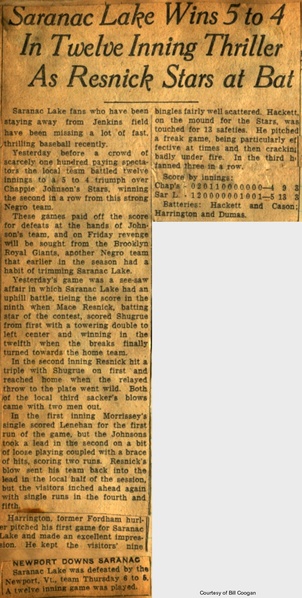 Circa 1930 ovide by Paul Smiths Electric Company. Sponsored by local merchants, including local bootlegger Bert LaFountain, Brighton won a remarkable 65 of 72 games in the 1948 season, powered by local heroes "Perk" Tormey and "Izzy" Amell.
Circa 1930 ovide by Paul Smiths Electric Company. Sponsored by local merchants, including local bootlegger Bert LaFountain, Brighton won a remarkable 65 of 72 games in the 1948 season, powered by local heroes "Perk" Tormey and "Izzy" Amell.
The Blues team was composed of local men ranging from 16 to 45. Rube Skeels, the eldest member of the team, took on the most demanding position, catching doubleheaders on Sunday afternoons and sometimes putting in another nine innings in an evening contest the same day. Many area families looked forward to unwinding from a hard day's work by watching Tormey turn double plays with Billy Root at shortstop behind pitching standouts Butler Sullivan and Ray Tarbox. Then the team managers decided to bring in semi-pro players to keep the team winning, a move that pushed several veteran players off the team and had them looking for a new place to play. As a result, several local businesses sponsored new teams in the area.
Russ "Bugs" Pratt and his brother Nate formed the Ray Brook Ramblers. In Saranac Lake two new teams were formed; American Legion Post 447 represented the local area in the Northern League while the Saranac Lake Majestics competed in the newly formed Champlain Valley Baseball League.
Lake Placid also fielded a team called the Majestics, owned by the same restaurant owner who sponsored the Saranac Lake team; they played in the Essex County League with Willsboro, Mineville, Port Henry and Keeseville.
As local baseball teams began to fragment the local fan base, it created financial problems in several of the teams. Shortly after the Essex County League folded, several local teams merged.
Adirondack Daily Enterprise, June 9, 1983
In Saranac Lake, baseball was king in 1930
Walter "Doc" Gatreau of Boston, standing 5-4 in baseball spikes, promised Saranac Lake "the fastest and finest baseball every played in the north country!" The year was 1936.
It was a promise that he kept and even improved upon for five consecutive years.
The Saranac Lake Red Sox dream teams still survive in the old Enterprise files.
The Red Sox joined seven other New York and Vermont communities, all to be seasonally endowed with top collegiate players from universities throughout the east and south. The Saranac Lake team alone during those colorful years welcomed diamond talent from Fordham, Yale, Syracuse, Holy Cross, Penn, Duke, Michigan, Rutgers, Wake Forest, Oglethorpe, Georgetown, Providence, Manhattan, University of Vermont and Springfield College.
The new Northern Baseball League provided many gifted players a springboard to the big leagues via the farm club system. Players of the caliber of George Stirnweiss and Jim Konstanty playing for Saranac Lake and the Malone Stars were an example.
But the most famous of all the local players signed by diminutive "Doc" Gatreau was Hank Borowy who hopscotched from Fordham University through Saranac Lake to the Newark Bears and finally to the New York Yankees.
When the 19-year-old Ram sophomore sauntered off the morning train on June 17, he was considered the hottest college pitcher in baseball. A month before his arrival he had notched 10 straight wins to tie the college record.
Hank was 5-10, weighed 160 pounds and pitched and batted righthanded. By the time he had finished his senior year at Fordham he had compiled a career record of 42 wins in 44 games and every major league team in the country had hopes of signing the greatest Ram star since Frankie Frisch.
Saranac Lake rolled out the welcome mat and his talent and quiet personality made an immediate hit with the fans.
It was not unusual for 4000 admirers to turn out to see his mound artistry and he seldom let them down. But it wasn't only Borowy. The entire team had more than a touch of class and gifted players manned every position.
Borowy was comfortable wearing the Saranac Lake Red Sox uniform. It was patterned after those worn by the New York Yankees except for the red band on the socks and the letters on the shirt. Borowy had set his mind on becoming a Yankee when he was 12-years-old.
The newly-franchised teams in the Northern Baseball League included the Plattsburgh Majors, the Tupper Lake Rangers, the Burlington Cardinals, the Malone Stars, the St. Albans Giants and Teams from Montpelier and Rutland. Lyon Mountain, Massena and Cornwall were added two years later.
Baseball fever was a very communicable disease in the north country all summer long. It was also beautifully supported. The local game program printed by Currier Press carried advertisements of 119 Saranac Lake area business enterprises and a booster club list of 195 individual names.
The limit for player "salary" was $1500 a month but spread over an expense formula to avoid jeopardizing the amateur standing of players eligible for further college play.
Hank Borowy, in fifth place in the local league standings at the halfway mark in his first year, had a 5-2 record. Eddie Jankowski, pitching for Montpelier, led the league with a perfect 7-0 record The four-letter star from Manhattan College opted for football on graduation and was signed by the Green Bay Packers.
Borowy realized he was in very fast company in the Northern Baseball League but he loved every minute of it. The local newspaper gave the Red Sox bountiful headline space all season long. A travelling fan club of 800 faithful rooters went to every, out-of-town game no matter where the team was scheduled to play.
When the League finally folded in August 1940, the winds of war were blowing this way. Most young men sensed that they would soon be wearing another kind of uniform.
That final summer had produced typically negative Adirondack weather: a very cold June! A July marked by deluge conditions cut the crowds in half. The economy was down. Frightening news from the European front contributed to the uneasiness.
But Hank Borowy and many other college players went on to lasting fame. Playing with the Newark Bears in 1941, Hank pitched in a special game against the Baltimore Orioles and set down 18 batters in a row. The third place Orioles were shocked.
Borowy is the only pitcher in major league history to have won World Series games for both American and National League teams and to start an All-Star Game. He won Series games for the New York Yankees in 1943 and the Chicago Cubs in 1945 and he started the All-Star Game for the American League in 1944 when he was with the New York Yankees.
When America entered the war he was sent to Alaskan army and navy bases at Kodiak, Anchorage and in the Aleutian Islands as a member of a sports cavalcade. His baseball companions were Frankie Frisch, Stan Musial, Danny Litwhiler and Dixie Walker.
The type of baseball promised and delivered by Walter "Doc" Gatreau in the 1930's was never to return to Saranac Lake or to any other community after the war. Colleges frowned on the semi-professional aspects of the resort baseball programs. Money was scarce for player expenses and few young players were available since most were returning war veterans reluctant to participate in a sport that sadly needed to be revived.
The fun chapters of the college athletes in Saranac Lake have faded into memory and only a few fans are still around who recall with clarity the sparkling years of the Saranac Lake Red Sox in the era between Prohibition and Pearl Harbor.
Adirondack Daily Enterprise, October 18, 1997
By BILL JOHNSON, Enterprise Sports Writer
A taste of baseball glory in the Tri-Lakes
With a roster featuring such established players as Skeels, Root and the Pratt brothers, the Saranac Lake Chiefs in 1950 would revive the dormant baseball spirits from the decade before and bring hordes of fans back to the aging Municipal Field for another taste of baseball glory.
Joining the league veterans in Chiefs uniforms were the likes of Wally Gay, Lou George, Clyde Baker, Basil Johnson and Rene Gendron, another generation of baseball standouts who were managed by a man by the name of Dusty Morgan, a former player with the Philadelphia Phillies who came to Saranac Lake looking to improve his health.
Morgan, who stayed in the Phillies organization as a scout after his playing days, was known as an "ivory hunter" in those days, a scout who was paid only when he signed a prospect. Dividing his duties with the Chiefs and the Phillies, Morgan's objective was to sign Mineville High's hard-throwing pitcher Johnny Podres to a professional contract.
However, Morgan would soon regain his health and leave the Chiefs, turning over the managerial reins to Skeels. Morgan would also leave the area without Podres, as the young star signed with Brooklyn scout Larry Isbel and went on to a stellar career with the Dodgers, earning the World Series MVP award some years later.
The Chiefs continued their winning ways throughout the decade until 1960 when changes in economic and social values turned fans away from sports as their primary form of entertainment. With a dwindling fan base, the Chiefs opted to disband that year, leaving Saranac Lake fans, once again, with only their memories.
Over a decade would pass before Saranac Lakers would get their next taste of baseball as local entrepreneur Dick Boyea formed the Saranac Lanes team in the summer of 1976. Stocking the roster with such local standouts as Danny Meade, Charlie Decker, Jeff Larocque and the Mace brothers, Jeff and Greg, the Lanes also went through a painful adjustment period as the more established teams of the Northern Valley League would often sharpen their stats when they visited the friendly confines of Schroeder's Field. However, unlike many of their predecessors, the Lanes grew stronger as their first season progressed, allowing them to play the spoiler against many of the elite teams in the league looking to secure a playoff spot.
In 1979 the Lanes changed their name to the Lakers and the managerial duties were handed over to Chuck Isele, a little league coach who had a knack for being in the thick of the playoff hunt for many years. Opening day 1979 marked a date that would have a significant impact on the team as they gathered to travel to AuSable Forks that day for the Champlain Valley League's season opener.
With departure time nearly upon them, Isele realized that they would only have eight men available for the contest and would run the risk of forfeiting the game. Third baseman Bert Hough mentioned to him that morning that a softball teammate of his would be interested in playing for the team if there was a need. With the need imminent Hough made his call and this teammate would make his debut that day going 2-for-5 in the contest with two extra base hits and become the cornerstone of a team that would rise to league prominence in the years to come.
From Rags to Riches
Stafford Branch was a tall, strong built man in his mid-20's who hailed from the Schenectady suburb of Scotia, N.Y. Throughout the first half of the 1979 season Branch would play a solid centerfield and swing a mighty bat as the Lakers began to take on the look of a league contender. Having established himself as one of the premier hitters in the league many did not realize that Branch had pitched some years earlier in the St. Louis Cardinals organization. Taking the necessary time to build his arm strength Branch took the mound one Sunday afternoon and re-wrote the record books as he led the league in strikeouts while pitching only half the season.
As the years passed, the Lakers would add more solid players to their lineup such as Dick Zerrahn, a local educator who played for nationally-ranked Ithaca College in his collegiate days and Pete Camelo, a, future prospect in the Montreal Expos organization, who is undoubtedly the best player ever to come out of Saranac Lake. Local restaurant owner Bill Jost Sr. would take over sponsorship of the team in 1981 allowing the players to focus more on playing the game rather than on fund-raising efforts
Behind Branch and Zerrahn's younger brother John, Club 86, as they were renamed, would dominate the opposition, winning the Champlain Valley Baseball League Southern Division title in 1980 and 1981. Dick Zerrahn would win the league batting title in 1981 while Branch would continue to destroy the opposition with both his arm and bat. However, despite all the success that they would experience in their rise to glory, Club 86 would suffer a serious setback after the 1981 season as Branch, John Zerrahn, Camelo and several others would leave the area to take employment elsewhere or to attend college.
As the second baseball drought set in many of the holdovers from the Club 86 squad would go on to stand out in the local slow-pitch softball league or travel to townships surrounding the area to catch on with other teams. In 1986 "Bugs" Pratt would return to the local baseball scene, fielding a team of locals from the high school and collegiate ranks who burst into the CVBL as a legitimate contender.
Led by former Lake Placid and Castleton State College standout Ken Reid, the Saranac Lake Merchants battled for and received the respect of all teams in the league, posting a winning record in their first year of existence. Pratt's son Tim, a crafty lefthander who was an all-conference selection at Cortland State, was the ace of the pitching staff, baffling the opposition with his assortment of breaking pitches and circle change-ups.
The complexion of the team changed as the years passed as the older players opted for the golf courses or the Black Fly Softball League, allowing younger players such as Brian Beckwith (St. John Fisher College), Bruce Van Weelden (Geneseo State), Jimmy Knight (Union College) and Scott Moody (LeMoyne College) to get experience and contribute to the team's success. As their Club 86 forefathers had done, the Merchants began their rise to the top of the league but would soon fall again as many of the younger players would head for school and leave local fans with only their memories to fall back on.
The area was once again without a team to support and only until this past summer was part of that void filled when former Legion Post 326 coach Rik Cassidy took over a struggling AuSable Spirits franchise and resurrected it by recruiting former players from his legion program and moving a portion of the home schedule to the Horse Show Grounds in Lake Placid.
Baseball once again became the family affair it was in the 40s as Cassidy's sons Sean, Chad and Wyatt would become important players in the resurgence of the Spirits. The arms of hard-throwing righthanders like Scott LeClerc and Scott Tower would be backed by the big bats of Van Weelden, D.J. Austin, Marshall Godin and Knight as the Spirits contended for the CVBL's Southern Division crown.
However, history would repeat itself once again as the Spirits would suffer a heartbreaking playoff loss that would end what was otherwise an outstanding season.
[The remainder of the article has to do with non-local baseball.]
(Special note: My thanks to Bud McGrain, Wally Gay and my father, Francis Johnson, for their vivid memories of the local game during the decades of the 1940s and 50s. Also to the Klarnick family, Julie, wife of the late Iron" Mike; his daughter Lori Klarnick-Morrison and her husband Marc, Varsity Baseball Coach at Hadley-Luzerne High School for their memories of Mike and the Saranac Lake Red Sox, and finally to the reader's of the Adirondack Enterprise who have been so appreciative of my work in this publication for the past several months. It has been both an honor and a privilege to serve you.)
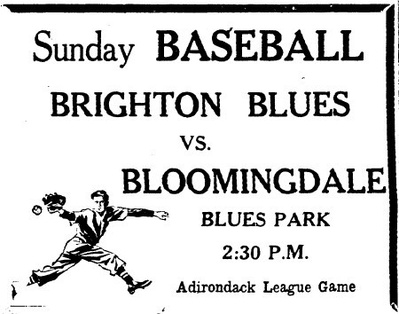 Baseball ad, Adirondack Daily Enterprise, June 8, 1957
Baseball ad, Adirondack Daily Enterprise, June 8, 1957
Adirondack Daily Enterprise, May 24, 1958
CHIEFS TO MEET SARANAC AWAY
The Adirondack Baseball League swings into its second week of play in the ten-team circuit with a slate of five games tomorrow afternoon, each contest billed to start at 2:30
The Saranac Lake Genesee Chiefs, minus the services of veterans Clyde Baker and Warren Schlickenrieder, fell before the invading Peru Chiefs last Sunday on Municipal Field where the Peruvians handed an 8-2 loss to the local nine in the opener for both clubs.
Baker and Schllckenjieder will be back in the infield lineup tomorrow when the Genesee Chiefs travel to Saranac, whose team lost a close one, 7-5, to Au Sable Forks last Sunday.
Leon La Fave or Arnie Dunn is slated to take the mound for the visitors with veteran Rube Skeels behind the bat to handle the slants of either southpaw, La Fave or righthanded Dunn, the former Lumberjack and Potsdam State two-sport star.
In the rest of the league action, the Bloomingdale Firemen will be in Morrisonville, last year's winner of the post-season playoffs title. The Dalers suffered a 15-0 trouncing at the hands of the '57 pennant-winning Lyon Mountain Miners last Sunday in their opener played on the Youth Commission Field in Bloomingdale while Morrisonville clobbered Cadyville, 21-1, the same afternoon In their opener at Cadyville.
The Brighton Blues of Gabriels, 11-2 victims of Dannemora Sunday on the Gabriels diamond, will invade Peru, while Cadyville opposes the always strong Lyon Mountain " club on the Miners' diamond.
Au Sable Forks will be at Dannemora to round out the full schedule of league play tomorrow.
Adirondack Daily Enterprise, August 22, 1972
Former teammates start Izzy Amell fund
By BILL MCLAUGHLIN
Hopefully 'Izzy' Amell's run of bad luck will end on Labor Day with the playing of the Old Timers game at the Bloomingdale ball field during the Labor Day program sponsored by the fire department.
Izzy, a former Brighton Blues and Saranac Lake Chiefs outfielder star in the period from 1945 until 1965 has lost a limb due to an arterial condition and has amassed hospital bills that threaten to snow him under. Several of his former teammates have decided to dedicate the Old Timer's game to Izzy and earmark the proceeds for a fund to help him meet the hospital bills.
Izzy will appear at the game which usually draws a fine crowd and brings out some of the rusting but relentless hitters and pitchers of an era known for sharp play and sterling performances at all positions.
Rube Skeels, one of the great catchers of the fame is helping to spearhead the drive along with Sandy Hayes to aid Izzy. They have high hopes of raising $1,000 one way or another and the Labor Day game figures to be a great start.
Others who have opened the front for the lzzy fund include ex-Saranac Lake diamond stars Clyde Baker, Billy Root, Bob Stringer, Harold Morgan and several out of the area athletes who feel that they can still help in some way.
If anyone has a special urge to send money or donate to the Izzy Amell Fund, checks can be mailed to either Rube Skeels or Sandy Hayes at 12 McClellan Street or Bloomingdale, N. Y.
The Old Timers classic starts at 3 p.m. traditionally and produces plenty or laughs and thrills. Help if you can . . . Your heavenly crown will shine a little bit brighter and you will hardly feel the pinch.
Adirondack Record, September 12, 1919
The Saranac Lake nine won over Chateaugay Sunday in a fine game at Chateaugay with a score of 7 to 6. A large number of Saranac Lake people motored to that town to attend the game which was well worth while. Neubauer and Shea pitched for Saranac Lake, while Lamy caught. Duprey pitched for the opposing team.
Baseball Fields:
See also
- James C. McClanahan
- Doc Gautreau
- Christy Mathewson
- Matty League
- Larry Doyle
- Saranac Lake Boys' Club
- Baseball in 1917
- Bill McCorry
External links
Comments
Marc, do you have source of SL Red Sox c.1940 photo?
Footnotes
1. Adirondack Enterprise, 7/3/48, p.4
2. The Vermont Encyclopedia
3. Adirondack Enterprise, 7/3/48, p.4
4. Adirondack Enterprise, 9/15/56, p.4


